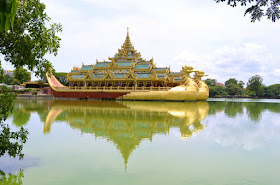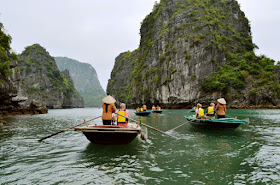Second day's itinerary, Shwedagon and Karaweik Hall (some refered it as Karaweik Palace). Both places are located beside Kandawgyi Lake, Shwedagon on the west, while Karaweik on the east. From our hotel, we took 10 minutes to reach Shwedagon by taxi, with 2,500 Kyat (RM8/ USD2.30), then 2,000 Kyat from Shwedagon to Karaweik Hall. We paid 2,500 Kyat to go back to our hotel at 38th Street from Karaweik Hall later.
Shwedagon means Golden Dagon (Dagon is the old name of Yangon). So, Shwedagon carries the meaning of Golden Yangon. It is the most sacred place for Buddhists in Yangon, and some believed that the stupa contains the relics of all past four Buddhas. Its sacredness didn't attract us. We went there because of its size and age.
Shwedagon Pagoda was built between 6th - 10th centuries. Then, it was left unattended for more than 400 years. Then, starting from 14th century, it was rebuilt and renovated several times to gain its present size, with the top of the stupa erected 99 meters above the ground. Elaborative temples were built encircled the stupa. Like Sule Pagoda, Shwedagon has 4 entrances.
We entered the pagoda through the lift at the south entrance, with entrance fee of USD5 (or 5000 Kyat). We hired an English speaking tour guide with USD5. The tour guide was really informative. He linked many part of the pagoda to the history of Myanmar, such as the lost and found of Maha Gandha Bell, the missing Dhammazedi Bell, and the statues of Buddha, which were donated by different parties. He highlighted that the giant stupa at the center of the pagoda was plated with genuine gold, topped with a big diamond. The decoration and gold items within the pagoda were donated by the believers.
99 meters stupa of gold, shine under the blazing sunlight. It was 9 in the morning, and the golden stupa started to shine under the sun. It was the time when the believers and tourists
pouring in. 9 am was just nice as the floor was warm. Visiting the pagoda
under hot afternoon sun may not be a good idea, as the floor will turn unbearably hot. The pagoda opens as early as 4 am and closes at 10 pm. We did read some article teaching us how to avoid paying to entrance fee. We personally don't think that is a good idea.
The magnificent stupa is surrounded by temples housing thousands of statues of Buddha. Most of these temples have pagoda like rooftop.
These are the temples on the western entrance.
How to differentiate the genuine gold plated structure to the one with golden paint? The colour. Real gold structures are less shiny compare to the stuctures with golden paint.
Maha Gandha bell is a 23-ton bronze bell. The bell was stolen but then fall into Yangon river. It was restored from Yangon River (upper left). Please do not confuse this Maha Gandha Bell with 40-ton Maha Tissada Gandha Bell (bell with three tones), which was donated by King Tharrawaddy in 1841. Our tour guide was telling the history of Shwedagon in the photo gallery (upper right). Pillars decorated with glass mosaic (lower right) in one of the temples around Shwedagon. Many parts of the pagoda are finely crafted.
The top of the stupa, with golden umbrella. Very top of it, a 76 carat (15 g) diamond.
We walked through the stairway of the southern entrance, with vendors selling souvenirs and books. The stairway was well decorated by fine woodwork and mural depicting the life of Buddha. We spent about two hours at Shwedagon.
The southern gate to Shwedagon is guarded by two giant lions. This photo shows one of the lions.
A long passage, about 150 meters, connecting the entrance to the pagoda. Many stalls are available on both sides of the passage.
The lift at the south of the pagoda, 50 meters away from the lions' guarded entrance. The lift service is free-of-charge. We kept our shoes at the south entrance.
Our next stop, Karaweik Hall. From Shwedagon, the taxi fare was 2000 Kyat. Entrance fee was required for both taxi and passengers at the main gate. We paid USD2 each. The hall was built in 1975, taking the design of a royal barge. Since then, the hall has became the symbol of Yangon and Myanmar. Frankly, Karaweik Hall is not a magnificent building. However, it is special because of the unique "duck" shaped structure. We took a walk along Kandawgyi Lake, tried to see the building from different angles. It was around 11:30 am, with the sun blazed unmercifully. Luckily, dense foliage protected us from serious sunburn. We took our lunch beside the lake.
Shwedagon can be clearly seen from Karaweik Hall.
Karaweik Hall from one of the restaurants beside the lake. The price of the food by the lake was more expensive compared to downtown. To our surprise, locals were outnumbered the tourists in the restaurants.
The bridge leads to the entrance of Karaweik Hall.
From the main gate, take a right turn and walk about 300 meters along the main walkway to reach a small bridge. That's the most strategic place to take photo with Karaweik Hall, free of charge (another location, which we think is even more strategic for photo taking, need extra payment to enter).
Shops in front of Karaweik Hall.
Back to our hotel, we took a long afternoon rest to avoid hot weather. We started our exploration within the area of 38th Street to Sule Pagoda Road again in late afternoon. Again, we tried a few types of street food, and finally, indulged ourselves at Parisian Cake and Coffee outlet beside Sule Pagoda Road.
For us, Shwedagon Pagoda and Karaweik Hall are the two places that worth a visit in Yangon. Shwedagon represents the historical, while Karaweik Hall, it's an icon.
We went to Bagan after staying in Yangon for two days. Returned from Bagan, we stayed in Yangon for another day. We did some shopping on the third day in Yangon. We will share about our experience in upcoming posts about Food in Yangon and Getting Around Yangon.
For us, Shwedagon Pagoda and Karaweik Hall are the two places that worth a visit in Yangon. Shwedagon represents the historical, while Karaweik Hall, it's an icon.
We went to Bagan after staying in Yangon for two days. Returned from Bagan, we stayed in Yangon for another day. We did some shopping on the third day in Yangon. We will share about our experience in upcoming posts about Food in Yangon and Getting Around Yangon.
























































